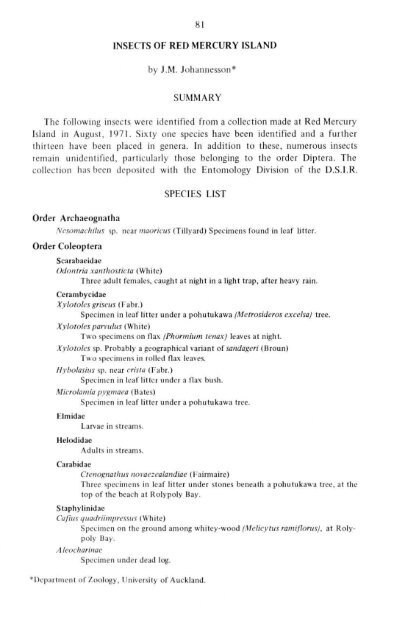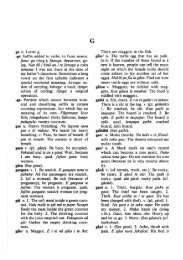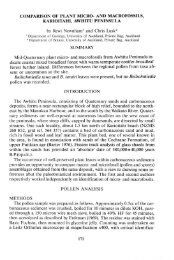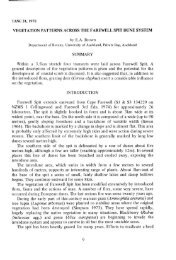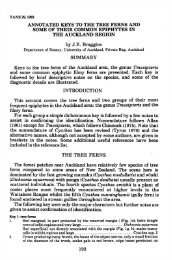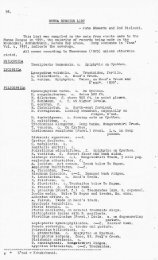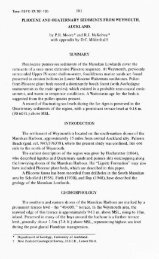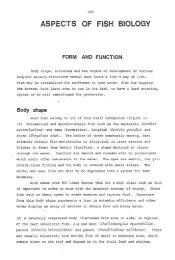Insects Of Red Mercury Island - Bookshelf Collection
Insects Of Red Mercury Island - Bookshelf Collection
Insects Of Red Mercury Island - Bookshelf Collection
You also want an ePaper? Increase the reach of your titles
YUMPU automatically turns print PDFs into web optimized ePapers that Google loves.
81<br />
INSECTS OF RED MERCURY ISLAND<br />
by J.M. Johannesson*<br />
SUMMARY<br />
The following insects were identified from a collection made at <strong>Red</strong> <strong>Mercury</strong><br />
<strong>Island</strong> in August, 1971. Sixty one species have been identified and a further<br />
thirteen have been placed in genera. In addition to these, numerous insects<br />
remain unidentified, particularly those belonging to the order Diptera. The<br />
collection has been deposited with the Entomology Division of the D.S.I.R.<br />
Order Archaeognatha<br />
SPECIES LIST<br />
Nesomachilus sp. near maoricus (Tillyard) Specimens found in leaf litter.<br />
Order Coleoptera<br />
Scarabaeidae<br />
Odontria xanthosticta (White)<br />
Three adult females, caught at night in a light trap, after heavy rain.<br />
Cerambycidae<br />
Xylotoles griseus (I abr.)<br />
Specimen in leaf litter under a pohutukawa (Metrosideros excelsa) tree.<br />
Xylotoles parvulus (White)<br />
Two specimens on flax (Phormium tenax) leaves at night.<br />
Xylotoles sp. Probably a geographical variant of sandageri (Broun)<br />
Two specimens in rolled flax leaves.<br />
Hybolasius sp. near crista (Fabr.)<br />
Specimen in leaf litter under a flax bush.<br />
Microlamia pygmaea (Bates)<br />
Specimen in leaf litter under a pohutukawa tree.<br />
Elmidae<br />
Larvae in streams.<br />
Helodidae<br />
Adults in streams.<br />
Carabidae<br />
Ctenognathus novaezelandiae (Fairmaire)<br />
Three specimens in leaf litter under stones beneath a pohutukawa tree, at the<br />
top of the beach at Rolypoly Bay.<br />
Staphylinidae<br />
Cafius quadriimpressus (White)<br />
Specimen on the ground among whitey-wood (Melicytus ramiflorus), at Rolypoly<br />
Bay.<br />
Aleocharinae<br />
Specimen under dead log.<br />
'Department of Zoology, University of Auckland.
Elateridae<br />
? Ctenicera sp.<br />
Cicindelidae<br />
82<br />
Larvae only, dug out of seaward cliff at south end of Rolypoly Ray.<br />
Neocicindela sp.<br />
Scraptiidae<br />
Two larvae dug out of seaward cliff at south end of Rolypoly Bay.<br />
Nothotelus sp.<br />
Alleculidae<br />
Omedes sp.<br />
Two specimens on flax leaves.<br />
Larvae dug out of cliff at north end of Rolypoly Bay.<br />
Melyridae<br />
Halyles nigrescens (Broun)<br />
Apionidae<br />
Specimen in leaf litter under flax bush.<br />
Neocyba metrosideros (Broun)<br />
Specimens in leaf litter.<br />
Curculionidae<br />
Praolepra infusca (Broun)<br />
Specimens on leaves of Coprosma sp.<br />
Sericotrogus subaenescens (Wollaston)<br />
Specimen in leaf litter.<br />
Irenimus compressus (Broun)<br />
Specimen on the ground among whitey-wood trees at Rolypoly Bay.<br />
Acalles intutus (Pascoe)<br />
Two specimens in leaf litter under a flax bush.<br />
Order Hemiptera<br />
Near Ugyops (Paracona) pelorus (lennah)<br />
Specimen on leaves of Coprosma sp.<br />
Pentatomidae<br />
Cermatulus nasalis<br />
Specimen found on leaves of Coprosma sp.<br />
Miridae<br />
Specimen on leaves of Geniostema ligustrifolium.<br />
Gerridae<br />
Microvelia sp.<br />
Specimens found in streams.<br />
Cicadellidae<br />
Nymphs on leaves of Geniostema ligustrifolium.<br />
Fulgoridae<br />
Cicadidae<br />
Nymphs under stone among flax bushes, at the top of the beach at<br />
Rolypoly Bay.<br />
Amphisalta sp.<br />
Kikihia sp.<br />
Exuviae only; in leaf litter.<br />
Exuviae only; in leaf litter.
Order Phasmida<br />
Phasmatidae<br />
83<br />
Clitarchus hookeri (White)<br />
A penultimate male; on the bark of a pohutukawa tree.<br />
Order Orthoptera<br />
Henicidae<br />
Hemiandrus similis (Ander)<br />
An adult female; under the bark of a pohutukawa tree.<br />
Rhaphidophoridae<br />
Neonetus sp.<br />
Male and female adults and nymphs; under the bark of pohutukawa trees and<br />
in dry leaf litter.<br />
Order Dermaptera<br />
Labiduridae<br />
Anisolabis littorea (White)<br />
Specimens in cracks of cliffs by the sea, and under stones at the top of<br />
beach (above high tide level) at Rolypoly Bay.<br />
Order Dictyoptera<br />
Blattidae<br />
Celatoblatta undulivitta (Walker)<br />
An adult female; under the bark of a pohutukawa tree.<br />
Order Psocoptera<br />
Philotarsidae<br />
Haplophallus maculatus (Tillyard)<br />
Specimen from manuka (Leptospermum scoparium).<br />
Order Odonata<br />
Zygoptera<br />
Xanthocnemis zelandica (Selys)<br />
An adult specimen; found dying by a stream at Lunch Bay. Nymphs were<br />
found in streams.<br />
Order Collembola<br />
Possibly Entomobryidae<br />
Specimen in leaf litter.<br />
Tomoceridae<br />
? Lepidophorella sp.<br />
Specimen in leaf litter.<br />
Order Hymenoptera<br />
Formicidae<br />
Chelaner antarctica (formerly Monomorium)<br />
A nest was found under a stone, among flax bushes at the top of the beach.<br />
Braconidae<br />
A pan teles sp. (probably ruficrus)<br />
An internal, gregarious parasite of lepidopterous caterpillars. An adult male;<br />
caught at night with a light trap.
Ichneumonidae<br />
Netelia ephippiata<br />
A parasite on caterpillars. Specimen caught at night with a light trap.<br />
S4<br />
Bombidae<br />
Bombus terrestris (Lin.)<br />
Specimens caught flying over manuka.<br />
Vespidae<br />
Vespula germanica (I'ered.)<br />
Specimens caught flying along the beaches.<br />
Order Diptera<br />
Coelopidae<br />
Chaetocoetopa littoralis (Button)<br />
Specimens caught at night with a light trap.<br />
Anisopodidae<br />
Anisopus neozelandicus (Schiner)<br />
Specimens caught at night with a light trap.<br />
Limoniidae<br />
? Limonia (Idioglochinia) sp.<br />
Specimens caught at night with a light trap.<br />
Sapromyzidae<br />
Sapromyza neozelandica (Tonnor and Malloch)<br />
Specimens caught flying through bush during the day, and at night with a<br />
light trap.<br />
Poecilohetaerella antennata (Harrison)<br />
Culicidae<br />
Opifex fuscus<br />
Specimen caught in light trap.<br />
Larvae and pupae in pools high up on beach, adults flying around beach at<br />
night.<br />
Trypetidae<br />
Tephritis sp. nr. thoracica (Malloch)<br />
Specimen caught in light trap.<br />
Calliphoridae<br />
Calliphora quadrimaculata<br />
Specimens caught in light trap.<br />
Calliphora laemica<br />
Specimens caught in light trap.<br />
Specimens from the following families were also obtained:<br />
Muscidae - adults; and larvae in streams.<br />
Mycetophilidae - adults.<br />
? Ceratopogonidae - adults.<br />
Tipulidae - adults.<br />
Limoniidae - adults.<br />
Stratiomyidae - larvae in streams.<br />
Dixidae - larvae in streams.
Chironomidae - larvae in streams.<br />
Heleidae larvae in streams.<br />
Psychodidae - larvae in streams.<br />
Order Lepidoptera<br />
H5<br />
All the specimens collected, except one, were adults, caught in a light trap at night, or<br />
caught Hying through the bush during the day.<br />
Geometridae<br />
Gelonia dejectaria (Walk)<br />
Larva feeds on most non-coniferous shrubs and large-leaved trees.<br />
Austrocidaria similata (Walk)<br />
Larva feeds on Coprosma spp.<br />
Selidosema suavis (Butl.)<br />
Larva feeds on all forest trees and shrubs.<br />
Helastia venipuncta<br />
Larva feeds on low herbs, often semi-succulent.<br />
Helastia lucidata (Walk)<br />
Larva feeds on low herbs.<br />
Epicyme rubropunctaria (Dbld.)<br />
Larva feeds on Haloragis spp.<br />
Poecilastnena pulchraria (Dbld.)<br />
Larva feeds on manuka and Cyathodes spp.<br />
Helastia rosearia (Dbld)<br />
Larva feeds on herbs.<br />
Helastia cineraria (Dbld.)<br />
Larva feeds on herbs.<br />
Phrissogonus testulatus (Guen.)<br />
Larva feeds on the flowers and fruit of shrubs.<br />
' 'Eucymatoge'' gobiata (Feld)<br />
Tortricidae<br />
Larva feeds on Coprosma spp.<br />
"Batodes" jactatana (Walk)<br />
Larva feeds on dying foliage.<br />
Ctenopseustis obliquana (Walk)<br />
Larva feeds on all vegetation.<br />
"Capua" semiferana (Walk)<br />
Larva feeds on dead leaves on the ground.<br />
Tineidae<br />
Lindera tessellata<br />
Dryadaula myrrhina (Meyrick)<br />
Pyralidae<br />
Scoparia sp. nr. meliturga<br />
Larva feeds on mosses.<br />
Musotima nitidalis (Walk)<br />
Larve feeds on Histiopteris incisa; also probably feeds on other ferns of the<br />
Lyonetiidae<br />
family Pteridaceae.<br />
Opogona (Hieroxestis) omoscopa<br />
Iarva feeds on plant debris.
Oechophoridae<br />
Gymnobathra flavidella (Meyr)<br />
Larva feeds on dead wood, or dead bark.<br />
Tineageriidae<br />
Stathmopoda skelloni<br />
Psychidae<br />
Larve feeds on dead leaves on the ground.<br />
Oeceticus omnivorus (I ercd.)<br />
Order Trichoptera<br />
Philanisidae<br />
Philanisus plebeius<br />
Larve found on manuka.<br />
A marine caddis fly. Male and female adults were caught in a light trap.<br />
Polycentopodidae<br />
Polyplectropus puerilis<br />
A fresh-water caddis fly. An adult female was caught in a light trap, and larvae<br />
and pupae were found in streams.<br />
Rhyacophilidae<br />
Psilochorema mimicum<br />
Larvae and pupae in streams.<br />
Psilochorema sp.<br />
Larvae in streams<br />
Helicopsyche albescens<br />
Larvae in streams.<br />
ACKNOWLEDGEMENTS<br />
I would like to thank Dr J.C. Watt of the Entomology Division, D.S.I.R.,<br />
Nelson, for the identification of the Coleoptera, and for the help he has given<br />
me in the preparation of this article. I would also like to thank Dr G.W. Ramsay,<br />
Dr G. Kuschel, Dr N.A. Martin, Dr E.W. Valentine, Dr J.S. Dugdale, and Dr A.C.<br />
Eyles, all of the Entomology Division, D.S.I.R., Nelson, for the identification of<br />
specimens. I am grateful to Mr D.R. Cowley of the Zoology Dept., University of<br />
Auckland, and to Mr K.A.J. Wise of the Auckland Institute and Museum, for<br />
the identification of Trichoptera. 1 also wish to thank Mr G. Watson for the<br />
collection and identification of fresh-water larvae and pupae.


